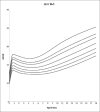Indian Growth References from 0-18-Year-Old children and Adolescents - A Comparison of Two Methods
- PMID: 32042700
- PMCID: PMC6987783
- DOI: 10.4103/ijem.IJEM_555_19
Indian Growth References from 0-18-Year-Old children and Adolescents - A Comparison of Two Methods
Abstract
Background and aims: For updating growth references, large datasets are usually required; collection of these data are expensive and cumbersome. Using a combination of regression equations, Preece Baines model and global LMS values, synthetic growth references for the target population can be generated. The objective of this study is to compare growth references created from continuous anthropometric data using LMS method versus those created synthetically from anthropometric means at key ages.
Methods: De-identified data on 46421 children (26037 boys) from 0-18 years of age from several multicentric studies conducted by the authors' group (2007 to 2017) were included in this study; growth references were constructed using the LMS method. For the production of synthetic references, arithmetic means of heights and weights at key ages were used and global LMS values were used from literature.
Results: There was no difference in the medians for height, weight and BMI between the references created by the two methods. The extreme percentile values for height were similar (P < 0.05). However, the spread of values for weight and BMI was narrower in the synthetic references.
Conclusion: Growth references produced from continuous data differ from those produced synthetically using anthropometric means mainly at the extreme centiles for weight and body mass index; synthetic references take into consideration global trends over several decades.
Keywords: Children; India; LMS method; height; synthetic growth references.
Copyright: © 2020 Indian Journal of Endocrinology and Metabolism.
Conflict of interest statement
There are no conflicts of interest.
Figures
Similar articles
-
First Ukrainian Growth References for Height, Weight, and Body Mass Index for Children and Adolescents Aged 7 to 18 Years.Biomed Res Int. 2018 Nov 11;2018:9203039. doi: 10.1155/2018/9203039. eCollection 2018. Biomed Res Int. 2018. PMID: 30534568 Free PMC article.
-
Nationwide reference data for height, weight and body mass index of Indian schoolchildren.Natl Med J India. 2011 Sep-Oct;24(5):269-77. Natl Med J India. 2011. PMID: 22680077
-
Establishing cross-sectional curves for height, weight, body mass index and waist circumference for 4- to 18-year-old Greek children, using the Lambda Mu and Sigma (LMS) statistical method.Hippokratia. 2015 Jul-Sep;19(3):239-48. Hippokratia. 2015. PMID: 27418784 Free PMC article.
-
Body Size of Male Youth Soccer Players: 1978-2015.Sports Med. 2017 Oct;47(10):1983-1992. doi: 10.1007/s40279-017-0743-x. Sports Med. 2017. PMID: 28523517 Review.
-
References.Perspect Med Virol. 1986;2:209-245. doi: 10.1016/S0168-7069(08)70043-0. Epub 2008 May 29. Perspect Med Virol. 1986. PMID: 32287595 Free PMC article. Review. No abstract available.
Cited by
-
Evaluation and Management of Achalasia Cardia in Children: A Retrospective Observational Study.J Indian Assoc Pediatr Surg. 2023 Sep-Oct;28(5):369-374. doi: 10.4103/jiaps.jiaps_175_22. Epub 2023 Apr 25. J Indian Assoc Pediatr Surg. 2023. PMID: 37842218 Free PMC article.
-
Global relevance of MGRS growth standards: the case of India.BMJ Paediatr Open. 2024 Mar 15;8(1):e002472. doi: 10.1136/bmjpo-2023-002472. BMJ Paediatr Open. 2024. PMID: 38490693 Free PMC article. Review.
-
An observational, multigenerational platform for health systems and population health interventions to minimise intergenerational transmission of non-communicable diseases in India: the YUVAAN cohort study protocol.BMJ Public Health. 2025 Feb 6;3(1):e001741. doi: 10.1136/bmjph-2024-001741. eCollection 2025. BMJ Public Health. 2025. PMID: 40017955 Free PMC article.
-
Comparison of Nutritional Status of Under-Five Indian Children (NFHS 4 Data) Using WHO 2006 Charts and 2019 Indian Synthetic Charts.Indian J Endocrinol Metab. 2021 Mar-Apr;25(2):136-141. doi: 10.4103/ijem.IJEM_18_21. Epub 2021 Sep 8. Indian J Endocrinol Metab. 2021. PMID: 34660242 Free PMC article.
-
Development of LMS and Z Score Growth References for Egyptian Children From Birth Up to 5 Years.Front Pediatr. 2021 Jan 18;8:598499. doi: 10.3389/fped.2020.598499. eCollection 2020. Front Pediatr. 2021. PMID: 33537262 Free PMC article.
References
-
- Khadilkar VV, Khadilkar AV, Cole TJ, Sayyad MG. Cross-sectional growth curves for height, weight and body mass index for affluent Indian children. Indian Pediatr. 2007;46:477–89. - PubMed
-
- Khadilkar VV, Khadilkar AV. Prevalence of obesity in affluent school boys in Pune. Indian Pediatr. 2004;41:857–8. - PubMed





